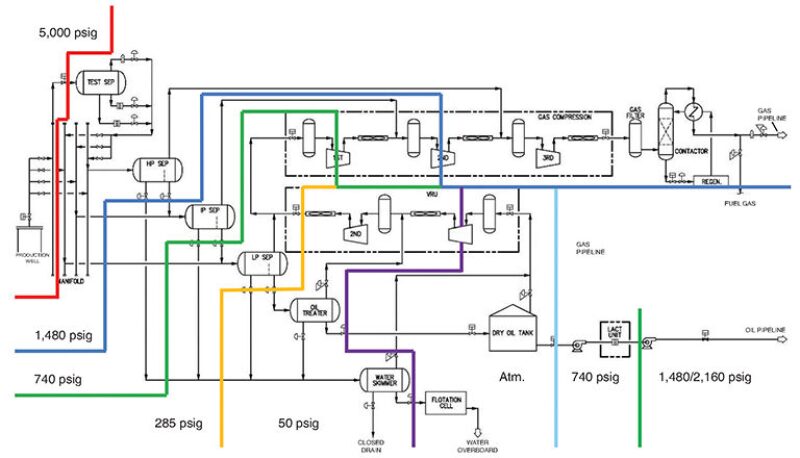
The application of lessons learned in projects is generally a trusted approach to tackling design challenges. However, the design of onshore production systems for unconventional resources does not allow for straightforward crossover from onshore or offshore conventional to unconventional systems.
Bryan Margo, a facilities engineering manager at Oil Field Development Engineering, said, “Shale and gas production is a young part of a much older industry.” For example, Petrohawk Energy (now part of BHP Billiton) drilled the first well in the Eagle Ford Shale in 2008, only 6 years ago.
Speaking at the SPE Gulf Coast Section’s Projects, Facilities, and Construction study group’s spring lecture series, Margo contrasted the configurations within process plants and highlighted the benefits of effective project planning and control through identification of the major milestones, risks, and risk mitigation.
Along with the relative recency of exploration and production (E&P) activity in unconventional resources, the volumes of production are measured in billions of barrels and trillions of cubic feet—higher volumes than the typical conventional resources and with larger areal extents. The economics and geologic success rates of E&P in unconventional resources has shifted the focus of the United States oil and gas industry from deepwater offshore and international to domestic onshore.
Table 1 shows the characteristics of the unconventional project schedule and the effects on the economics of the project.
The nascent shale plays pose challenges related to the factors in Table 1. The shorter time frames desired to bring production on line mean that companies have less time to develop standards, define typical facility designs, and to develop a shale culture within their organizations. To ensure a successful project, schedule, economics, experience, standards, guidelines, and philosophies must be addressed.
Finding experienced personnel requires bringing in people from other industries, such as conventional onshore, midstream, downstream, offshore, international, and pipeline areas. Each person comes with an organizational culture (consciously or not) of familiarity and experience with different regulations, standards, philosophies, and expectations. For example, Margo said, “Something that is an ‘absolutely not’ in another part of the industry is sometimes ‘just right’ for shale. This makes it difficult to find the right balance until a shale culture is established.”

Design for Pressure Protection
Margo emphasized that “safety is sacred. If we can’t make it safe, we should go home.” However, there is an inherent risk in oil and gas production. The engineers designing a facility are the first line of defense in protection from overpressure and leaks, which can result in fires and explosions. He said that doing things “lean and mean, but safe, is not a bad thing.”
Finding the balance among general equipment specification, company design philosophies, design guidelines, and procedures takes time and money. The design of a production system for an unconventional resource project may be fully engineered or it may use vendor standard packaged equipment.
If a production system is fully engineered, the overall system and equipment packages are designed and specified by the project, which incurs higher engineering costs and longer schedules, but provides more control over the final design compared with a system that uses vendor standard packaged equipment.
The owner designs the overall system and the vendor designs the packages when using standard equipment. This approach lowers engineering costs and allows for faster schedules while allowing the owner to maintain control in the overall design.
Margo used the design of pressure protection as an example in the differences in production systems in unconventional resources. He said that Eagle Ford wells have a typical shut-in tubing pressure of less than 5,000 psig and the flowing pressures exceed ANSI Class 600 flanged system ratings. Design pressures typically drop in the liquid handling systems as the oil and water are treated, then climb during the processes of gas compression and oil export.
The changes in design pressure, or specification breaks, require a comprehensive approach to pressure protection. Figs. 1 through 3 show the differences in specification breaks in onshore conventional, offshore shelf, and onshore shale production facilities.



Margo said there are no legally required codes, standards, or regulatory requirements to guide the systematic design of onshore pressure protection. The American Petroleum Institute’s recommended practice (API RP 14C) for the analysis, design, installation, and testing of basic surface safety systems for offshore production platforms has been suggested as an option for providing guidance. Although it is legally applicable to the offshore US Gulf of Mexico, the recommendation is also used internationally. It defines minimum pressure protection devices, such as relief valves and pressure shutdowns.
He added that a process hazards analysis is a design verification tool, not a design tool (no major safety issues should be caught in the analysis).
Documentation of the design (drawings, data sheets, specifications, calculations, and reports) provides an auditable confirmation of a safety system design and repeatability in the design of a new facility. It also helps to provide continuity with changing personnel and improves the ability of performing brownfield modifications.

